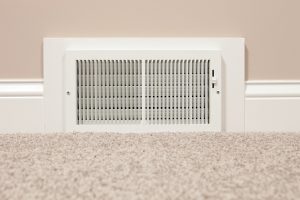Summer is right around the corner. As the weather starts to heat up, you may be wondering what you need to do to make sure your central air conditioning system is in top shape.
Here are eight things you can do today to make sure your AC unit is ready to cool your home this summer.
1. Clean or Replace Air Filters
The air filters in your AC system prevent dust, pollen, and dirt from damaging the components. AC filters remove particulate that can end up on the evaporator coil and condenser coil, and cause ice buildup. When the coils in your HVAC unit get dirty and cause icing, this can lead to damage, requiring them to be replaced.
Replacing filters is one of the easiest steps in AC system maintenance. Your central AC system should have a replaceable filter near the air handler cabinet, where the air intakes. There may also be air filters at the air return registers. Plan on replacing these filters every couple of months, or whenever they look clogged with dust, dander, and dirt.
2. Clean Condenser Coils
The condenser unit of a central air conditioning system is typically located outside the home, on a concrete slab. It is a large metal box with sides that look like grilles. This unit contains a fan, usually on top, and condenser and evaporator coils. These coils use refrigerant to move heat energy from one environment to another. The condenser coil disperses heat energy into the outside air after removing it from the inside environment.
To DIY clean it, first make sure the power is shut off at the electrical box. If the condenser unit has been covered for winter with a tarp, uncover it. The grilles usually detach with a screwdriver. You must use a soft brush specially made for this purpose, you can find these online, to carefully clean the coils and fins. Particular care must be taken to not bend or damage the fins.
The outer grilles should be cleaned of any dirt and debris gently with a hose and dried thoroughly before reattaching.
3. Clear Debris from Outside Condenser/Compressor
The outside condenser unit should be kept free of vegetation and debris. Make sure there are no bushes or plant growing around it. Any blockages around it can result in poor and restricted airflow, leading to potential damage to the unit.
4. Check Refrigerant Level
There should be two copper lines that lead to the condenser unit outside. The larger line should have insulation around it. When you touch this line, it should feel cold to the touch. When the air conditioning is running, there might be some condensation on this line. This is your refrigerant line, which helps move heat energy. If you touch this line after running the cooling cycle, and it feels warm to the touch, call a HVAC technician to add refrigerant to this line.
5. Clean the Condensate Drain
This drain is usually a tin PVC pipe near the outdoor condenser unit. When you run the cooling cycle of the HVAC unit, you will see water dripping from this pipe. Because this pipe has condensed water vapor and water, sometimes algae can accumulate here. You do not want any algae or debris clogging the condensate drain, or the water may end up flowing back into the home when you ramp up using the air conditioning.
To clean the condensate drain, remove the end of the drain, which usually has a perpendicular elbow. Use a wet-dry shop vac to remove the water and algae sludge from the line. When finished, replace the end of the drain.
6. Inspect Air Vents and Registers
Look at the air vents and registers around the inside of your home. Make sure they are free of dust and dander. If they are currently being blocked by drapes, curtains, furniture, or other encumbrances, clear the path so they can get proper airflow.
7. Visually Inspect Ductwork
The ductwork in your home is the series of conduits that transport conditioned air to different rooms. This can be flexible metallic tubes or rigid ductwork, usually metallic in the walls, ceilings, or floors of your home.
When you run the air conditioning, if the air seems overly humid during warmer months, or if there appears to be dust in the air, your ductwork may have a leak. A local HVAC contractor can help you replace the ductwork if it turns out you have a leak. If you have leaky ductwork, do not ignore it, as it can lead to water condensation outside the ductwork, and in the structure of your home.
8. Test the AC Unit
The last step on our check list is to test the AC unit by running it early in the warmer season. You don’t need to run it until the home is all the way cool, but enough to make sure that cool air running through the vents inside.
Set the inside thermostat to 68°, or whatever temperature is required to run the cooling cycle on the AC. You should notice the cool air cycle kick on. Go outside and make sure the outside condenser/compressor is running. Check the vents inside your home and ensure that cold air is blowing. If everything else on the list looks good, you should be good to go for summer.
Conclusion
If you have a question about your central air conditioner, or need a service call for AC repair in San Jose, Morgan Hill, or Gilroy, call Ventwerx HVAC at (408) 710-9595. We have served the South Bay and Central Coast since 2007.
Whether you require installation, repair, or maintenance, our technicians will assist you with top-quality service at any time of the day or night. Take comfort in knowing your indoor air quality is the best it can be with MOE heating & cooling services Ontario's solution for heating, air conditioning, and ventilation that’s cooler than the rest.
Contact us to schedule a visit. Our qualified team of technicians, are always ready to help you and guide you for heating and cooling issues. Weather you want to replace an old furnace or install a brand new air conditioner, we are here to help you. Our main office is at Kitchener but we can service most of Ontario's cities
Source link



Add Comment